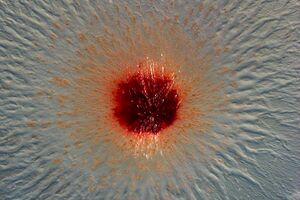Pendulispora rubella: Difference between revisions
| Line 57: | Line 57: | ||
[Sample reference] [http://ijs.sgmjournals.org/cgi/reprint/50/2/489 Takai, K., Sugai, A., Itoh, T., and Horikoshi, K. "''Palaeococcus ferrophilus'' gen. nov., sp. nov., a barophilic, hyperthermophilic archaeon from a deep-sea hydrothermal vent chimney". ''International Journal of Systematic and Evolutionary Microbiology''. 2000. Volume 50. p. 489-500.] | [Sample reference] [http://ijs.sgmjournals.org/cgi/reprint/50/2/489 Takai, K., Sugai, A., Itoh, T., and Horikoshi, K. "''Palaeococcus ferrophilus'' gen. nov., sp. nov., a barophilic, hyperthermophilic archaeon from a deep-sea hydrothermal vent chimney". ''International Journal of Systematic and Evolutionary Microbiology''. 2000. Volume 50. p. 489-500.] | ||
[https://www.ncbi.nlm.nih.gov/nuccore/NZ_CP089983.1 Garcia,R., Popoff,A., Bader,C.D., Loehr,J., Walesch,S., Walt,C., Boldt,J., Bunk,B., Haeckl,F.J.F.P.J., Gunesch,A.P., Birkelbach,J., Nuebel,U., Pietschmann,T., Bach,T. and Mueller,R. "Discovery of the Pendulisporaceae a myxobacterial family with distinct sporulation behavior and unique specialized metabolism". ''Unpublished''. 2024. | [https://www.ncbi.nlm.nih.gov/nuccore/NZ_CP089983.1 Garcia,R., Popoff,A., Bader,C.D., Loehr,J., Walesch,S., Walt,C., Boldt,J., Bunk,B., Haeckl,F.J.F.P.J., Gunesch,A.P., Birkelbach,J., Nuebel,U., Pietschmann,T., Bach,T. and Mueller,R. "Discovery of the Pendulisporaceae a myxobacterial family with distinct sporulation behavior and unique specialized metabolism". ''Unpublished''. 2024.] | ||
==Author== | ==Author== | ||
Revision as of 20:32, 17 November 2024
Classification
Bacteria; Myxococcota; Myxococcia; Myxococcales; Sorangiineae; Pendulisporaceae
Species
|
NCBI: [1] |
Pendiluspora rubella
Description and Significance
Describe the appearance, habitat, etc. of the organism, and why you think it is important.
Genome Structure
Describe the size and content of the genome. How many chromosomes? Circular or linear? Other interesting features? What is known about its sequence?
Pendulispora rubella has a circular genome with 10,733 total genes. Named GCF_037157805.1-RS_2024_10_26 and fully mapped on 10/26/2024 12:40:18.
Cell Structure, Metabolism and Life Cycle
Interesting features of cell structure; how it gains energy; what important molecules it produces.
Ecology and Pathogenesis
Habitat; symbiosis; biogeochemical significance; contributions to environment.
If relevant, how does this organism cause disease? Human, animal, plant hosts? Virulence factors, as well as patient symptoms.
References
Author
Page authored by Colleen Bolmanski, Dakota Lowery, & Beckham LaBarbera, students of Prof. Bradley Tolar at UNC Wilmington.

